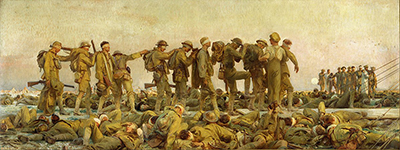When John Singer Sargent was commissioned in 1918 by the British Ministry of Information, his brief was to create a work that celebrated what was described by the Ministry as Anglo-American cooperation
Upon his arrival in France with fellow artist Henry Tonks in the late summer of 1918, Sargent found it a challenge to source suitable material for his commission. What both he and Tonks encountered, however, was the stark reality of life for soldiers on the Western Front, a reality chillingly evoked in letters that both artists wrote of what they had witnessed.
Given the news that a gas attack had recently occurred within swift travelling distance, Sargent made his way to the scene. The horrors that awaited him had a profound effect, resulting in the creation of Gassed, utterly dissimilar to the somewhat celebratory expectation of the original commission.
Sargent remarked later that the Ministry expected an epic work and there was no better way to fulfil this than by demonstrating the suffering of masses of men.
The concept of an epic work is, upon initial examination, rather literal in the context of the painting's scale of 231 cm to 611 cm. Uccello's triptych, The Battle of San Romano, is an acknowledged influence upon the sheer size of Gassed, although Sargent's work is larger than Uccello's innovative masterpiece.
The linear perspective of the medieval painting is evoked in Gassed, with the viewer's eye following a stark line of artistic narrative. Similarly, Sargent's depiction of a line of wounded soldiers resonates with The Parable of the Blind, by Brueghel the Elder, wherein both artists invite the viewer to observe the scenes as unfolding journies.
Despite the scale of Gassed, Sargent's strokes are deft, lightly applied in oils to sublime effect, drawing the viewer into a world unimaginable, the medium itself beautiful and technically skilled, with the result a scene of nightmares. John Singer Sargent also gained inspiration from classic artworks such as The Blue Boy by Thomas Gainsborough and Las Meninas by Diego Velazquez.
'Gassed' gives a side view of a line of soldiers heading to medical tents following a mustard gas attack. Sargent's use of neutral tones evokes the nature of the gas itself, a sickly amber hue reflecting the nauseous, oily quality that mustard gas is known for.
In the line of men, blindfolded as they are from the stinging effects on their eyes, Brueghel's influence is evident, wherein a line of figures, hindered as they are, progress to some destination whose resolution is unknown. The soldiers pick their way across a duckboard, reliant upon one another as they place a hand upon the shoulder of the man ahead of them, led as a chain by an orderly.
Sargent emphasises the blinding effects with a soldier raising a leg as if to negotiate a step, whilst disorientation is portrayed by another man with his back to the viewer, perhaps veering from the line. Despite a strong connection to the French master, Singer Sargent's approach to these types of subjects was not matched within any Monet paintings, with him preferring to concentrate solely on portraits and landscapes.
The peripheral scenes inform the central line of men, serving to juxtapose the relentless progress of day to day life with the immediate suffering of those recently gassed. In the background, amidst a parallel line of blindfolded men, a soldier is leaning on his side to vomit.
The foreground depicts another line of suffering men, one soldier desperately drinking from a water bottle. To amplify the horror of the scene, a group of men in the background are enjoying a football match, seemingly impervious to the scenes of desperation around them, the sun's lengthening shadows creating an otherworldly vista.
Sargent makes use of the physically fit men playing football to emphasise that appalling suffering can exist alongside a deceptive normality in war, suggesting that survival on the Western Front is a moment by moment experience.
The lines of men portray a collective suffering, emphasising the indiscriminate nature of mustard gas and the lack of protective equipment worn by the victims. They wend their way towards the dressing station, situated at right, and the viewer cannot help but muse on the outcomes for these men, bedraggled and beaten down by a weapon that is unique in its potency to instil terror and panic.
Sargent skillfully depicts the uncertain nature of a gas attack, the men stripped as they are of any meaningful resistance to it. There is, perhaps, an underlying criticism of the inadequacies of the management of gas attacks. A sense of hopelessness pervades the scene, with the artist using a football game to demonstrate the regularity of gas warfare on the Western Front.
The painting's reception was generally positive, upon its completion in 1919. Although Virginia Woolf described it as overly triumphal, Winston Churchill referenced its 'painful significance', resonating with the recent aftermath of the Great War. The painting's redemptive quality, with the men making their way to the dressing tents, is not negated by the themes of endurance and suffering, the soldier's expressions making explicit the horrors they have lived through. The co-dependence of the men as they support one another along the duckboard conveys elements of both camaraderie and necessity, a homage to the survival of these men and others like them under appalling conditions.
Gassed is displayed by the Imperial War Museums, although the painting is currently on a North American tour and will return to the UK for viewing sometime in late 2018. It is a memorable work, fierce upon the physical senses and uncompromising in its visceral depiction of violence. Here, then, is Sargent's epic work, rendered unforgettable by its honesty, a parable of conflict that suggests the capacity of the human will to endure and survive the darkest despair of war.




